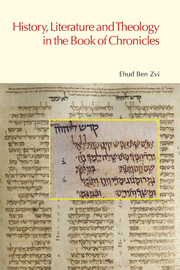Book contents
- Frontmatter
- Dedication
- Contents
- Acknowledgments
- Abbreviations
- Part I INTRODUCTORY ESSAYS
- Part II CHRONICLES AND THE REREADING AND WRITING OF A DIDACTIC, SOCIALIZING HISTORY
- Part III CHRONICLES AND THEOLOGY AS COMMUNICATED AND RECREATED THROUGH THE REREADING OF A HISTORIOGRAPHICAL, LITERARY WRITING
- Chapter 8 A SENSE OF PROPORTION: AN ASPECT OF THE THEOLOGY OF THE CHRONICLER
- Chapter 9 OBSERVATIONS ON WOMEN IN THE GENEALOGIES OF 1 CHRONICLES 1–9
- Chapter 10 IDEOLOGICAL CONSTRUCTIONS OF NON-YEHUDITE/PERIPHERAL ISRAEL IN ACHAEMENID YEHUD: THE CASE OF THE BOOK OF CHRONICLES
- Chapter 11 A GATEWAY TO THE CHRONICLER'S TEACHING: THE ACCOUNT OF THE REIGN OF AHAZ IN 2 CHRONICLES 28.1–27
- Chapter 12 THE AUTHORITY OF 1–2 CHRONICLES IN THE LATE SECOND TEMPLE PERIOD
- Part IV CHRONICLES AND LITERATURE: LITERARY CHARACTERIZATIONS THAT CONVEY THEOLOGICAL WORLDVIEWS AND SHAPE STORIES ABOUT THE PAST
- Bibliography
- Index of Biblical Works Cited
- Index of Authors and Individuals Cited
Chapter 10 - IDEOLOGICAL CONSTRUCTIONS OF NON-YEHUDITE/PERIPHERAL ISRAEL IN ACHAEMENID YEHUD: THE CASE OF THE BOOK OF CHRONICLES
from Part III - CHRONICLES AND THEOLOGY AS COMMUNICATED AND RECREATED THROUGH THE REREADING OF A HISTORIOGRAPHICAL, LITERARY WRITING
- Frontmatter
- Dedication
- Contents
- Acknowledgments
- Abbreviations
- Part I INTRODUCTORY ESSAYS
- Part II CHRONICLES AND THE REREADING AND WRITING OF A DIDACTIC, SOCIALIZING HISTORY
- Part III CHRONICLES AND THEOLOGY AS COMMUNICATED AND RECREATED THROUGH THE REREADING OF A HISTORIOGRAPHICAL, LITERARY WRITING
- Chapter 8 A SENSE OF PROPORTION: AN ASPECT OF THE THEOLOGY OF THE CHRONICLER
- Chapter 9 OBSERVATIONS ON WOMEN IN THE GENEALOGIES OF 1 CHRONICLES 1–9
- Chapter 10 IDEOLOGICAL CONSTRUCTIONS OF NON-YEHUDITE/PERIPHERAL ISRAEL IN ACHAEMENID YEHUD: THE CASE OF THE BOOK OF CHRONICLES
- Chapter 11 A GATEWAY TO THE CHRONICLER'S TEACHING: THE ACCOUNT OF THE REIGN OF AHAZ IN 2 CHRONICLES 28.1–27
- Chapter 12 THE AUTHORITY OF 1–2 CHRONICLES IN THE LATE SECOND TEMPLE PERIOD
- Part IV CHRONICLES AND LITERATURE: LITERARY CHARACTERIZATIONS THAT CONVEY THEOLOGICAL WORLDVIEWS AND SHAPE STORIES ABOUT THE PAST
- Bibliography
- Index of Biblical Works Cited
- Index of Authors and Individuals Cited
Summary
1. Introductory Considerations
This examination of a key ideological theme in ancient Yehud, at least among the literati who produced and for whom much of the literature that eventually became included in the Hebrew Bible elite was produced, contributes to the study of the history of common worldviews held among the ideological elite of Yehud, and as such to the history of Yehud.
Certainly, the literati of Achaemenid period Jerusalem were well aware that not all ‘Israel’ (hereafter, Israel) lived in Yehud. How did they explain this obvious fact of their lives in acceptable ideological terms? What kind of conceptual, discursive maps emerged out of the acknowledgment of a reality in which there was Yehudite and non-Yehudite Israel? Although I will focus here on the light that the book of Chronicles sheds on these questions, some crucial, general observations about the ideological milieu of Achaemenid Yehud are in order.
The fact that Israel existed in Yehud and outside its borders led by necessity to ideological constructions in Jerusalem of (a) a self-perceived center, namely Yehud along with the central attributes associated uniquely with it such as Jerusalem, Zion, Jerusalemite temple, and sociologically, the Jerusalemite literati themselves, and (b) non-Yehud, that is, by definition a periphery devoid of such ideological attributes and institutions. Moreover, since the discourse/s of the Yehudite literati included, at its core, a deeply embedded image and main meta-narrative of ‘exile and return’, the pair of center and periphery often, but not necessarily fully overlapped that of center/diaspora or exile.
- Type
- Chapter
- Information
- History, Literature and Theology in the Book of Chronicles , pp. 195 - 209Publisher: Acumen PublishingPrint publication year: 2006



